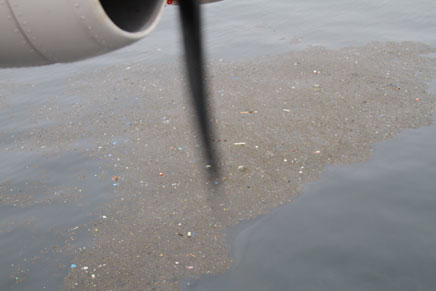Litter on the North Sea
Litter on the North Sea is a growing problem. In addition to communication, awareness and clean-up actions, the emphasis is on prevention by dealing with the source and closing the loop. International cooperation is necessary since the spread is not limited to national borders.
Plastic soup, also in the North Sea
(Plastic) litter in the sea, also known as plastic soup, is a growing problem with negative consequences for the marine ecosystem, while also involving social, safety, economic and possibly health issues. Because of the international nature of the problem, the Netherlands is working actively with other countries in the North East Atlantic area (in an OSPAR context). The problem is also being addressed in other international forums, such as the International Maritime Organisation (IMO) and the UNEP Global Partnership on Marine Litter (GPML). In addition, the issue is on the agendas of the international river commissions, such as the International Meuse Commission (IMC) and International Rhine Committee (IRC). The main sources of marine litter are shipping, fishing, beach recreation and riverine contributions from land-based sources.
On a global level, it is estimated that 80% of the litter at sea comes from land. For the North Sea, this percentage appears to be lower. An analysis of beach waste on Dutch beaches reveals that 44% comes from sources at sea (shipping / fishing), 30% from land (especially from beach tourism), and 26% is unknown. Three quarters of the waste is plastic, both larger pieces of plastic as well as micro plastic. Dealing with litter in catchment basins is an important starting point for reducing the amount of litter in the sea.
Marine Strategy Framework Directive, the driving force
At this moment, the Marine Strategy Framework Directive (MSFD) is the main legal framework. The EU Member States, including the Netherlands, are required to take measures to achieve and/maintain good environmental status (GES) in their marine waters by 2020. The Netherlands takes an active role in the implementation of this Directive.
The Dutch efforts for addressing marine litter take place in different contexts: on a local, national, regional and global level. An international approach is necessary since the spread of litter in seas and oceans is not limited to national borders.
In the Marine Strategy, the government aims to reduce the amount of litter on the coast (beach waste) and the impact on marine organisms ('plastic particles in the stomachs of Northern Fulmars’) by 2020. The GES objective formulated in the MSFD is as follows: "The characteristics of, and the quantities of marine litter shall not cause harm to the coastal and marine environment."
The two environmental goals set for 2020 are:
- The amount of visible litter on the coast has decreased
- There is a downward trend in the amount of litter in marine organisms
In addition to the objectives laid down in the Marine Strategy, a process has been initiated to strengthen the policy commitment to address the issue through additional measures. In the reduction of litter, the Netherlands focuses, in accordance with the opinion of the Government, on prevention through an integrated source approach, awareness and closing product chains (Marine Strategy, Part I (pdf, 4.1 MB)). This can be achieved by applying various policy instruments: regulation, product policies, consumer policies and information and education. The Netherlands also implements effect control.
In summary, the Netherlands focuses on:
- Preventing the emergence of litter (including through Green Deals, product requirements and waste policies)
- Rehabilitation by cleaning up the beaches and through the Fishing for Litter project
- Communication and awareness
Closing the loop
The elaboration of the Dutch effort is formalised within the context of 'green growth' Letter of Parliament on Green Growth, March 2013). The efforts serve the higher purpose of achieving a transition to a sustainable economy in which production / consumption cycles are closed: the transition ‘from waste to resource’, ‘cradle to cradle’, discouraging the use of disposable consumer goods (plastic bags, plastic packaging) and the transition to a non-disposable culture / circular economy. Many actions will therefore need to be taken within other contexts, such as sustainable consumption and production (SCP). Examples include requirements for packaging, eco-design, waste management, etc. The Plastic Value Chain Agreement, signed on 12 November 2013, has brought together parties that make joint agreements on how to close the loop.
Green Deals
New additional measures have been included in the European Marine Strategy Framework Directive Programme of Measures. The draft was made available for consultation until 22 June, and will be adopted by the Parliament by the end of 2015. The implementation of the programme will start on 1 January 2016. Some of the new measures in the European Marine Strategy Framework Directive Programme of Measures against marine litter are contained in so-called Green Deals: the Ship Waste Chain Green Deal (pdf, 303 kB), the Fishery for a Clean Sea Green Deal (pdf, 117 kB) and the Clean Beaches Green Deal (pdf, 188 kB). The Ministry also takes action to improve the inclusion of the marine litter problem in educational materials, to reduce large-scale balloon releases and to prevent micro-beads in cosmetics. In the catchment basins, different parties are working together in cleaning activities in rivers and in the exchange of knowledge about litter.
OSPAR Regional Action Plan Marine Litter
On 28 June 2014, OSPAR established the Regional Action Plan (RAP) Marine litter. The plan describes actions for common measures and goals. The Netherlands has a leading role in the development of a large number of OSPAR measures. These OSPAR actions will extend the range of national actions.
